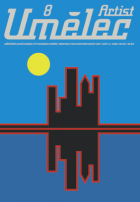| Umělec 1998/8 >> Jen Budney | Просмотр всех номеров | ||||||||||||
|
|||||||||||||
Jen BudneyUmělec 1998/801.08.1998 Gabriele Di Matteo: Pět obrazů | exhibition | en cs |
|||||||||||||
|
"The Italian artist Gabriele Di Matteo has painted Yasser Arafat five times. These black and white paintings are gigantic (2.05 meters by 1.45 meters), and identical, or at least as identical as five hand-painted pictures ca be. Di Matteo has selected a newspaper’s close-up mug shot of the famous Palestinian leader as his guide; it is severely cropped around his beard and scarf, but it is a handsome portrait - Arafat smiles calmly, his eyes twinkling in that notoriously devilish way. Those who support the Palestinian cause can’t help but smile back in response: though plenty would claim that Arafat’s devilishness is of the particularly evil kind, to many others his mischievous express recalls nothing more sinister than the coy Jack Nicholson.
It is this gregariousness which has made Arafat such a popular figure in the imaginations of so many people around the world. Even those who don’t follow Middle Eastern politics know his face; indeed, he is one of the most recognizable figures of the late 20th century, after a handful of movie stars, and as far as political figures go, he might just to the list. But aside from claiming some mild affection for Arafat, Di Matteo has not set out to produce an homage to him. His project is a painterly one: a struggle at the boundaries of a practice which, despite the valiant efforts of the historical avant-garde, has not been made obsolete, but is nevertheless always left to reflect upon the failed project of its obsolescence. Jeff Wall has called representational painting “a neurotic world of substitution“. This was not meant as a slight, but as an explanation for the avant-garde’s drive towards the monochrome - initiated, perhaps, by Caravaggio, and continued through the likes of Cezanne, Mondrian, Picasso, Rodchenko, and the New York School of Pollock, Newman, and Rothko. These artists’ efforts to achieve an art form that was not bourgeois failed famously, and future generations of painters, such as Warhol, Richter, and On Kawara, were left to work consciously within the delirious tension, or irony, of the “dialectic of negativity“ - thus painting after-the-fact, or attempting to render when valid representations are no longer possible. Di Matteo is continuing this investigation here, as he has in previous work. At first glance, these paintings really do look like photographs; it is only when the viewer approaches them closely that the individual markings of paint upon canvas become visible. A comparison of the paintings reveals many subtle variations of tone and form - Di Matteo never succeeded in matching the colors exactly, and some mouths are more crooked than others, etc. But the result of the grouping as a whole is uncanny: you imagine these paintings being ripped off the walls to be joined with those mass produced posters and banners at a rally, and you become uncomfortably aware of the emotional power of the icon. In the end, for Di Matteo, the paintings are a successful failure; he wanted to produce five absolutely identical images, but he knew he never could. For the rest of us, they prove again painting’s burden: it will always tend toward sign painting. "
01.08.1998
Рекомендуемые статьи
|
|||||||||||||





Комментарии
Статья не была прокомментированаДобавить новый комментарий